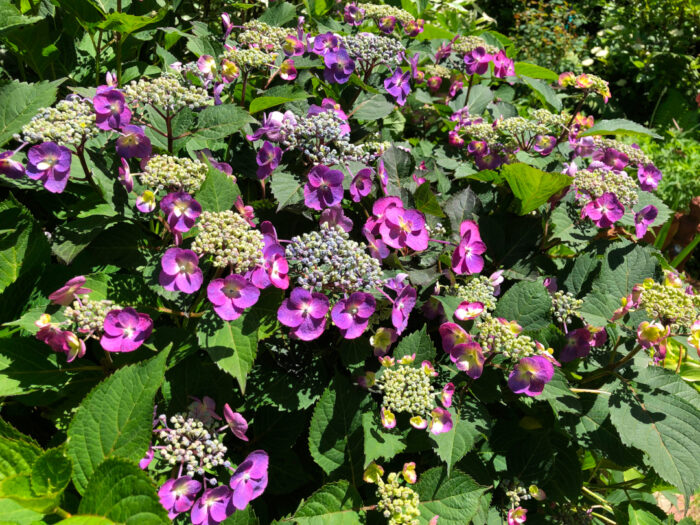Today we’re going back to June with Carla Zambelli Mudry, looking at some photos from hydrangea season in her garden in Malvern, Pennsylvania.
I have a deep love for hydrangeas. I rediscovered them as an adult visiting the Hamptons in New York. They are an integral part of the summer landscape up there and are very tough and indestructible plants. I love the diversity of hydrangeas available. Among my favorites are those with airy fairy lacecap flowers.
I think every garden should have hydrangeas, just like I think every garden should have roses.
This lacecap hydrangea is in full bloom (Hydrangea macrophylla or H. serrata, Zones 5–9). “Lacecap” is a term used to describe hydrangeas that have a ring of large, showy, sterile flowers around the outside of the bloom, and a cluster of smaller, fertile ones in the middle. This is the normal form for these plants in the wild, with the large, sterile flowers serving to draw pollinators in to the fertile blooms in the middle.
This lovely lacecap hydrangea is a rich shade of purple. The color of hydrangea blooms is a combination of the soil and the genetics of the individual variety. The hydrangea plant needs aluminum to produce the blue pigment. In acidic soils, aluminum is very available and is easily taken up into the plant to make rich blue colors. In more alkaline soils, aluminum is chemically bound to the soil and the plants can’t absorb it, so the flowers stay pink.
A beautiful pink lacecap form, delicate and graceful
Mophead varieties produce mostly large sterile flowers instead of just an outer ring like in the lacecap types. This means they can produce few if any seeds, but they really make an over-the-top display in the garden.
Think you don’t have room for a hydrangea? Many of the newer varieties are quite compact and will thrive in a container. Just give them a little extra protection from winter cold by moving them into a shed or garage if you live in a cold climate.
While the classic mophead and lacecap hydrangeas are native to Asia, the smooth hydrangea (Hydrangea arborescens, Zones 3–9) is native to the southeastern United States. Much more cold hardy than their Asian relatives, they’re easy to grow in nearly every garden and make big heads of white flowers.
Smooth hydrangeas generally have white flowers, but new breeding has produced pink forms, a wonderful addition to this fantastic plant.
Another great species of hydrangea native to the southeastern United States is the oakleaf hydrangea (Hydrangea quercifolia, Zones 5–9), with big, conical flower heads and beautifully bold foliage.
Have a garden you’d like to share?
Have photos to share? We’d love to see your garden, a particular collection of plants you love, or a wonderful garden you had the chance to visit!
To submit, send 5-10 photos to gpod@taunton.com along with some information about the plants in the pictures and where you took the photos. We’d love to hear where you are located, how long you’ve been gardening, successes you are proud of, failures you learned from, hopes for the future, favorite plants, or funny stories from your garden.
Have a mobile phone? Tag your photos on Facebook, Instagram or Twitter with #FineGardening!
Do you receive the GPOD by email yet? Sign up here.
Fine Gardening Recommended Products
The New Organic Grower, 3rd Edition: A Master's Manual of Tools and Techniques for the Home and Market Gardener, 30th Anniversary Edition
Fine Gardening receives a commission for items purchased through links on this site, including Amazon Associates and other affiliate advertising programs.
Since its original publication in 1989, The New Organic Grower has been one of the most important farming books available, with pioneer Eliot Coleman leading the charge in the organic movement in the United States. Now fully illustrated and updated, this 30th Anniversary Edition is a must-have for any agricultural library.
DeWalt Variable-Speed Cordless Reciprocating Saw with 6-Piece Saw Blade Set
Fine Gardening receives a commission for items purchased through links on this site, including Amazon Associates and other affiliate advertising programs.
You can fit a variety of blades to this saw to cut fallen branches or prune larger limbs from trees in a pinch. It’s fast, tough, easy to use, and extremely versatile.
- 18.31 x 6.13 x 4 inches
- 1-1/8-inch stroke length
- Variable speed trigger with 0-3000 spm
- DW4856 Metal/Woodcutting Reciprocating Saw Blade Set, 6-Piece
ARS Telescoping Long Reach Pruner
Fine Gardening receives a commission for items purchased through links on this site, including Amazon Associates and other affiliate advertising programs.
Telescopes from 4 to 7'. Cut and Hold (160) Blades. Drop forged blades for unsurpassed long lasting sharpness. Lightweight, 2.3 lbs., for continued use. Perfectly balanced for easy pruning.






























Comments
Seeing your summer photos of your Hydrangeas was so refreshing!
Love that lavender lacecap!
Log in or create an account to post a comment.
Sign up Log in